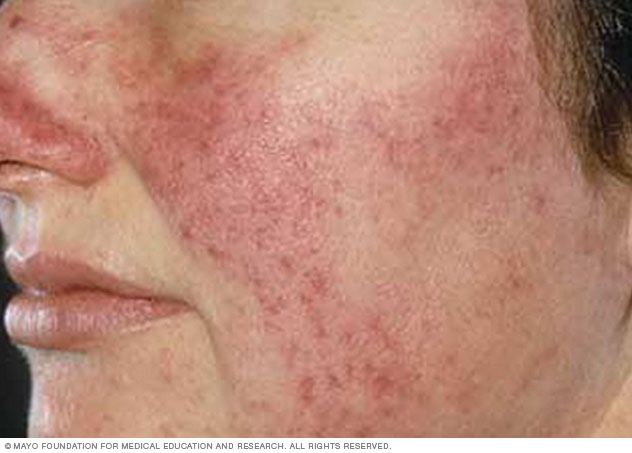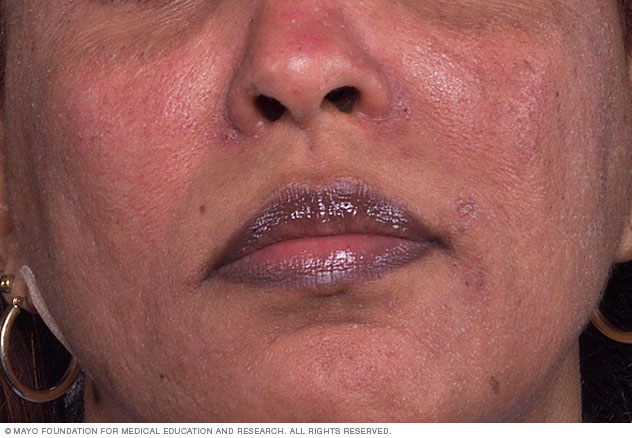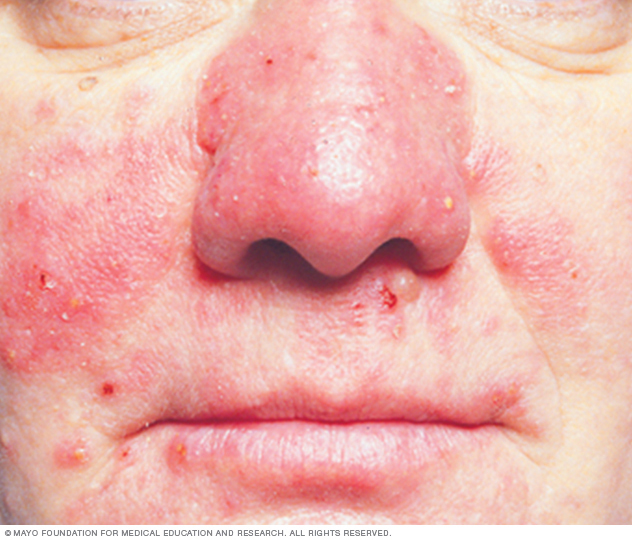Rosacea (roe-ZAY-she-uh) is a common skin condition that causes blushing or flushing and visible blood vessels in your face. It may also produce small, pus-filled bumps. These signs and symptoms may flare up for weeks to months and then go away for a while. Rosacea can be mistaken for acne, other skin problems or natural ruddiness.
Rosacea can affect anyone. But it's most common in middle-aged white women. There's no cure for rosacea, but treatment can control and reduce the signs and symptoms.

Changes typical of rosacea on white skin are redness of the cheeks, nose and central face, with small red bumps or pustules.

The flushing or blushing of rosacea may be difficult to see on brown and Black skin. Watch for other signs of the condition.
Symptoms
Signs and symptoms of rosacea include:
- Facial blushing or flushing. Rosacea can cause a persistent blushing or flushing in the central part of your face. This sign of the condition may be difficult to see on brown and Black skin.
- Visible veins. Small blood vessels of your nose and cheeks break and become visible (spider veins).
- Swollen bumps. Many people with rosacea also develop pimples on their face that resemble acne. These bumps sometimes contain pus.
- Burning sensation. The skin of the affected area may feel hot and tender.
- Eye problems. Many people with rosacea also experience dry, irritated, swollen eyes and eyelids. This is known as ocular rosacea. In some people, the eye symptoms precede the skin symptoms.
- Enlarged nose. Over time, rosacea can thicken the skin on the nose, causing the nose to appear bulbous (rhinophyma). This occurs more often in men than in women.
When to see a doctor
If you experience persistent symptoms of your face or eyes, see your doctor or a skin specialist (dermatologist) for a diagnosis and proper treatment.

Over time, rosacea can thicken the skin on the nose, causing the nose to appear bulbous (rhinophyma). This occurs more often in men than in women.
Causes
The cause of rosacea is unknown, but it could be due to an overactive immune system, heredity, environmental factors or a combination of these. Rosacea is not caused by poor hygiene and it's not contagious.
Flare-ups might be triggered by:
- Hot drinks and spicy foods
- Red wine and other alcoholic beverages
- Temperature extremes
- Sun or wind
- Emotions
- Exercise
- Drugs that dilate blood vessels, including some blood pressure medications
- Some cosmetic, skin or hair care products
Risk factors
Anyone can develop rosacea. But you may be more likely to develop it if you:
- Are female
- Have skin that burns easily in the sun
- Are over age 30
- Smoke
- Have a family history of rosacea
Diagnosis
No specific test is used to diagnosis rosacea. Instead, your doctor relies on the history of your symptoms and an examination of your skin. You may have tests to rule out other conditions, such as psoriasis or lupus. Studies show that in people of color, rosacea can be missed or misdiagnosed as an allergic reaction or seborrheic dermatitis.
If your symptoms involve your eyes, your doctor may refer you to an eye specialist (ophthalmologist) for evaluation.
Treatment
Treatment for rosacea focuses on controlling signs and symptoms. Most often this requires a combination of good skin care and prescription drugs.
The duration of your treatment depends on the type and severity of your signs and symptoms. Recurrence is common.
Medications
New rosacea medications have been developed in recent years. The type of medication your doctor prescribes depends on which signs and symptoms you're experiencing. You may need to try different options or a combination of drugs to find a treatment that works for you.
Prescription drugs for rosacea include:
-
Topical drugs that reduce flushing. For mild to moderate rosacea, your doctor may prescribe a cream or gel that you apply to the affected skin. Brimonidine (Mirvaso) and oxymetazoline (Rhofade) reduce flushing by constricting blood vessels. You may see results within 12 hours after use. The effect on the blood vessels is temporary, so the medication needs to be applied regularly to maintain improvements.
Other topical products help control the pimples of mild rosacea. These drugs include azelaic acid (Azelex, Finacea), metronidazole (Metrogel, Noritate, others) and ivermectin (Soolantra). With azelaic acid and metronidazole, noticeable improvements generally don't appear for two to six weeks. Ivermectin may take even longer to improve skin, but it results in a longer remission than does metronidazole.
- Oral antibiotics. Your doctor may prescribe an oral antibiotic such as doxycycline (Oracea, others) for moderate to severe rosacea with bumps and pimples.
- Oral acne drug. If you have severe rosacea that doesn't respond to other therapies, your doctor may suggest isotretinoin (Amnesteem, Claravis, others). It's a powerful oral acne drug that also helps clear up acnelike lesions of rosacea. Don't use this drug during pregnancy as it can cause serious birth defects.
Laser therapy
Laser therapy can make enlarged blood vessels less visible. Because the laser targets visible veining, it's most effective on skin that isn't tanned, brown or black.
Talk with your doctor about the risks and benefits of laser therapy. Side effects of laser therapy for rosacea include swelling and bruising that might last for several days. Icing and gentle skin care will be needed during the recovery period. On brown or black skin, laser treatment might cause long-term or permanent discoloration of the treated skin.
The full effect of the treatment might not be noticeable for weeks. Repeat treatments may be needed periodically to maintain the improved appearance of your skin.
Laser treatment for rosacea is usually considered a cosmetic procedure, which insurance typically doesn't cover.
Lifestyle and home remedies
These self-care practices may help you control the signs and symptoms of rosacea and prevent flare-ups:
- Identify and avoid triggers. Pay attention to what tends to cause flare-ups for you and avoid those triggers.
-
Protect your face. Apply sunscreen liberally daily before going outdoors. Use a broad-spectrum sunscreen — which blocks both ultraviolet A and ultraviolet B rays — with an SPF of 30 or higher. Apply sunscreen after you apply any topical medication you are using for your face, and before applying any cosmetics.
Take other steps to protect your skin, such as wearing a hat and avoiding midday sun. In cold, windy weather, wear a scarf or ski mask.
- Treat your skin gently. Don't rub or touch your face too much. Use a nonsoap cleanser twice a day and moisturize. Choose fragrance-free products, and avoid those that contain other skin irritants, such as alcohol, camphor, urea and menthol.
- Reduce visible flushing with makeup. Some makeup products and techniques may help reduce the appearance of skin flushing.
Alternative medicine
Gentle daily facial massage may help reduce swelling and inflammation. Use a circular motion with your fingers starting on the central part of the face and work toward the ears.
A recent study suggests that caffeine may reduce the risk of developing rosacea. Even so, hot beverages are a common trigger.
Many other alternative therapies — including emu oil, laurelwood and oregano oil — have been touted as possible ways to treat rosacea. But no conclusive evidence supports the idea that any of these substances are effective.
Talk with your doctor about the pros and cons of specific alternative therapies.
Coping and support
Rosacea can be distressing. You might feel embarrassed or anxious about your appearance and become withdrawn or self-conscious. You may be frustrated or upset by other people's reactions. Consider talking with a counselor about these feelings.
A rosacea support group, either in person or online, can connect you with others facing the same types of problems — which can be comforting.
Preparing for an appointment
You're likely to start by seeing your family doctor. Or when you call to set up an appointment, you may be referred to a skin disease specialist (dermatologist). If your condition affects your eyes, you may be referred to an eye specialist (ophthalmologist).
It's a good idea to prepare for your appointment. Here's some information to help you.
What you can do
Preparing a list of questions will help you make the most of your appointment time. For rosacea, some basic questions to ask your doctor include:
- What might be causing the signs and symptoms?
- Do I need tests to confirm the diagnosis?
- What is the best treatment?
- Is this condition temporary or chronic?
- Is there a generic alternative to the medicine you're prescribing?
- I have other medical problems; how can I manage them together?
- Can I wait to see if the condition resolves on its own?
- What are the alternatives to the approach that you're suggesting?
- What skin care routines do you recommend I use?
Don't hesitate to ask any other questions that come up during your appointment.
What to expect from your doctor
Your doctor is likely to ask you several questions, including:
- When did you begin experiencing symptoms?
- How often do you experience these symptoms?
- Have your symptoms been continuous or occasional?
- What, if anything, seems to improve your symptoms?
- What, if anything, appears to trigger or worsen your symptoms?
Copyright © 1998-2025 Mayo Foundation for Medical Education and Research (MFMER). All rights reserved.